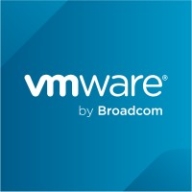

Oracle VM and VMware vSphere compete in the virtualization and cloud infrastructure category. VMware vSphere seems to have the upper hand due to its extensive enterprise-grade features and robust management tools.
Features: Oracle VM is notable for reducing licensing costs for Oracle products through hard partitioning and trusted partitions, is open-source, offers high security, and supports a wide range of hardware. VMware vSphere provides high availability, distributed resource scheduling, robust management tools, and support for a broad range of operating systems, which makes it suitable for high-performance environments requiring scalability and integration capabilities.
Room for Improvement: Oracle VM could enhance data backup and snapshot capabilities, improve the user interface, and ensure capabilities for hot backups and cloning jobs directly from Oracle VM Manager. VMware vSphere users want improvements in licensing policies, new release stability, and a more intuitive management console. There is also a desire for better integration with other platforms and simplified configurations.
Ease of Deployment and Customer Service: Oracle VM's open-source and free nature, along with good support service, is advantageous for Oracle hardware users. Its deployment process and support documentation are well-regarded, although technical support effectiveness varies. VMware vSphere offers strong deployment capabilities across hybrid, public, and private clouds, with improved technical support, though cost and complexity remain concerns.
Pricing and ROI: Oracle VM provides a cost-effective solution with free licensing for Oracle hardware users and pay-for-support options, leading to reduced licensing costs and fast ROI for Oracle customers. VMware vSphere offers flexible licensing tailored to enterprise needs, justified by its comprehensive features and integration capabilities, despite higher licensing fees. It provides a robust virtualization platform widely accepted in enterprises but with a higher pricing curve compared to Oracle VM.
We can say 10% is the approximate amount of savings because most of the things are automated and streamlined, so the manual work is eliminated in most cases.
The response time and quality of support could be improved.
If we have issues, the support tends to be unreliable
Priority one issues are usually addressed by engineers within one to two hours.
Recently, support has been less friendly and slower, especially after the company was acquired by Broadcom.
VMware vSphere is highly scalable in terms of the number of users and the number of servers it can handle.
It is a highly scalable solution.
Scaling is easy, whether it is hyperconverged or a three-tier architecture.
Not every upgrade goes smoothly, and after an upgrade, it sometimes stops working.
It is a very stable hypervisor solution.
While they are generally stable, if outages occur, they tend to be due to brands like HP or Dell, not VMware vSphere itself.
I would rate the stability of VMware vSphere as eight out of ten.
Oracle VM provides automation capabilities in the new version.
If I have limited systems and there is maintenance on the hardware, the Oracle systems are impacted.
Not every upgrade goes smoothly, and after an upgrade, it sometimes stops working.
Although the product is very strong and includes all necessary features, the high pricing drives many customers to avoid using it.
Another area is the stability during upgrades from older versions to newer versions, where we face issues.
Sometimes, it is difficult to find documentation for specific tools and solutions.
Oracle VM is not a very expensive solution.
Many customers are trying to avoid it due to its high cost.
Costs significantly increased from perpetual to subscription, with prices rising by two to three times over three to five years.
About three or four years ago, I would have recommended VMware vSphere more strongly, but currently, the price and licensing issues are deterrents.
If there is an issue with the operating system running on top of it, there's no primary and secondary domain, rather segregated I/Os, disks, memory, everything assigned to a logical domain.
It is easy to copy or clone one Oracle workstation to another.
The vMotion feature is beneficial for online migration of virtual machines from one host to another without downtime.
The tool is highly available, which is crucial for implementing critical applications requiring 24/7 availability.
We utilize features such as the motion and Distributed Resource Scheduler (DRS) for automatically managing resources.
| Product | Market Share (%) |
|---|---|
| VMware vSphere | 16.5% |
| Oracle VM | 7.0% |
| Other | 76.5% |


| Company Size | Count |
|---|---|
| Small Business | 34 |
| Midsize Enterprise | 20 |
| Large Enterprise | 37 |
| Company Size | Count |
|---|---|
| Small Business | 172 |
| Midsize Enterprise | 138 |
| Large Enterprise | 256 |
Oracle VM for x86
Oracle VM for x86 is a Xen based server virtualization platform for public and private cloud and traditional on premise deployment. Oracle VM offers full lifecycle and application deployment from disk to cloud.
Designed and optimized for security, efficiency and performance Oracle VM supports major hardware vendors x86 and storage platforms and can run workloads on Linux, Windows and Oracle Solaris. Uniquely for our virtualization platform it offers live patching via Ksplice enhancing security and minimizing service disruption. Oracle VM supports hard partitioning which can significantly reduce software applications licensing costs.
Oracle VM for SPARC
Oracle VM for SPARC is a firmware based virtualization platform for Oracle and Fujitsu SPARC based servers running Solaris. Oracle VM supports hard partitioning which can significantly reduce software applications licensing costs.
VMware vSphere is a versatile virtualization platform known for its ease of use, flexibility, and high availability. It supports seamless migration, optimal resource allocation, and centralized management, making it highly suitable for diverse infrastructure needs.
VMware vSphere is widely adopted for its virtualization capabilities that enhance hardware efficiency and ensure minimal downtime through features like High Availability and Distributed Resource Scheduler. Despite criticisms about high licensing costs and limited fault tolerance, it remains a preferred choice due to its stability, scalability, and robust integration options. Users appreciate its efficiency in managing virtual machines and hosting enterprise applications, although challenges with web client performance and hardware compatibility are noted. Organizations often look for better integration with cloud services and enhanced automation and scalability.
What are the core features of VMware vSphere?
What benefits and ROI can businesses look for?
VMware vSphere is implemented across sectors like healthcare, finance, and education for server virtualization, data center management, and private cloud creation. Its use in facilitating business-critical operations ensures high availability and efficient resource use, supporting both development and production environments.
We monitor all Server Virtualization Software reviews to prevent fraudulent reviews and keep review quality high. We do not post reviews by company employees or direct competitors. We validate each review for authenticity via cross-reference with LinkedIn, and personal follow-up with the reviewer when necessary.